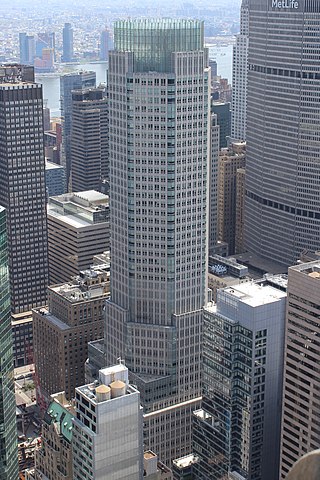
JPMorgan Chase & Co. is an American multinational financial services firm headquartered in New York City and incorporated in Delaware. It is the largest bank in the United States and the world's largest bank by market capitalization as of 2023. As the largest of the Big Four banks in America, the firm is considered systemically important by the Financial Stability Board. Its size and scale have often led to enhanced regulatory oversight as well as the maintenance of an internal "Fortress Balance Sheet". The firm is headquartered at 383 Madison Avenue in Midtown Manhattan and is set to move into the under-construction JPMorgan Chase Building at 270 Park Avenue in 2025.

Henry Roberts Kravis is an American businessman, investor, and philanthropist. He is a co-founder of KKR & Co. Inc.

James Dimon is an American businessman who has been the chairman and chief executive officer (CEO) of JPMorgan Chase since 2006.

The Bear Stearns Companies, Inc. was an American investment bank, securities trading, and brokerage firm that failed in 2008 during the 2007–2008 financial crisis and the Great Recession. After its closure it was subsequently sold to JPMorgan Chase. The company's main business areas before its failure were capital markets, investment banking, wealth management, and global clearing services, and it was heavily involved in the subprime mortgage crisis.

Wasserstein Perella & Co. was a boutique investment bank established by Bruce Wasserstein, Joseph R. Perella, Bill Lambert, and Charles Ward in 1988, former bankers at First Boston Corp., until its eventual sale to Dresdner Bank in 2000 for some $1.4 billion in stock. The private equity business of the investment firm was not included in the sale and was to be sold off to existing Wasserstein shareholders.
Alan David Schwartz is an American businessman and is the executive chairman of Guggenheim Partners, an investment banking firm based in Chicago and New York City. He was previously the last president and chief executive officer of Bear Stearns when the Federal Reserve Bank of New York forced its March 2008 acquisition by JPMorgan Chase & Co.

383 Madison Avenue, formerly known as the Bear Stearns Building, is a 755 ft (230 m), 47-story skyscraper in the Midtown Manhattan neighborhood of New York City, New York, U.S. Built in 2002 for financial services firm Bear Stearns, it was designed by architect David Childs of Skidmore, Owings & Merrill (SOM). It housed Bear Stearns's world headquarters until 2008, when Bear collapsed and was sold to JPMorgan Chase. Since then, JPMorgan's investment banking division has occupied the building.
Howard Schenken was an American bridge player, writer, and long-time syndicated bridge columnist. He was from New York City. He won three Bermuda Bowl titles, and set several North American records. Most remarkably he won the Life Master Pairs five times, the Spingold twelve, and the Vanderbilt Trophy ten times; the LM Pairs and Vanderbilt records that still stand today.

James E. "Jimmy" Cayne was an American businessman and CEO of Bear Stearns. In 2006, he became the first Wall Street chief to own a company stake worth more than $1 billion, but he lost most of that in the 2007–2008 collapse of Bear's stock and sold his entire stake in the company for $61 million.
One Equity Partners is a private equity firm with over $10 billion in assets under management which primarily deals with the industrial, healthcare and technology sectors in North America and Europe. One Equity Partners was the merchant banking arm of JPMorgan Chase, focused on leveraged buyout and growth capital investments in middle-market companies. Formed by Bank One in 2001, the group has offices in New York City, Chicago, São Paulo, Vienna, Hong Kong and Frankfurt.

House of Cards: A Tale of Hubris and Wretched Excess on Wall Street is the second book written by William D. Cohan. It was released on March 10, 2009 by Doubleday.
Geoffrey Raymond is an American painter. He is best known for painting embattled Wall Street CEOs, then exhibiting them in a public place and inviting pedestrians who pass by to annotate his work with Sharpies. His painting style is described as a Jackson Pollock/Chuck Close fusion. Because of the physical incorporation of public commentary on the face of his works, his Wall Street series expands the notion of traditional portraiture and becomes both painted depictions and historical documentation of the 2007–2008 financial crisis.
Alexandra Lebenthal is an American businesswoman. She was the President and Chief Executive Officer of the municipal bond franchise Lebenthal & Company until June 2017.
B. Jay Becker was an American lawyer and bridge champion from Flushing, Queens.
Richard Lincoln Frey was an American contract bridge player, writer, editor and commentator. From New York City, he died of cancer there in 1988.
Sherman Drakeley Stearns was an American contract bridge player from New York and a member of the championship Four Aces team.
Frank J. Bisignano is an American businessman and the president and CEO of Fiserv. He previously was the CEO of First Data, and the COO of JPMorgan Chase.
Alfred J. Koeppel was an American real estate executive and attorney. Koeppel was a member of one of the oldest real estate families in New York, and a board chairman at Trinity College in Hartford, Connecticut.
The Four Aces was a contract bridge team which dominated tournament play in the mid-thirties.







